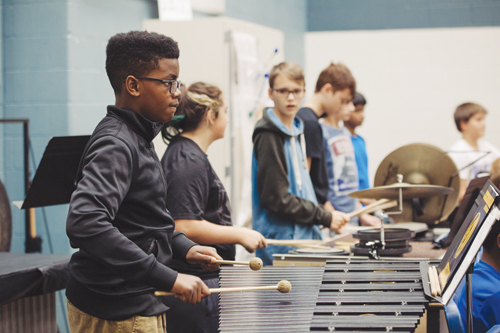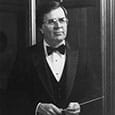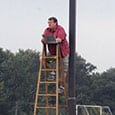I remember feeling quite fortunate to begin the band program in a newly constructed school the first time walking into my classroom. After three years of elementary music, I finally had my chance to teach instrumental music, which was my original goal. I was ready to pick out some favorite pieces, teach them to my new students, perform them well at festival and hopefully earn the chance to go to state.
Reality set in after the first year; students performed at a lower level than I expected, and fewer students than I would have liked stayed in band. Like many new teachers, I fell into the trap of putting content before students and was more excited about what I was going to conduct than who I was conducting. When students decided to leave my program, I took it personally. I practically begged certain students not to quit, which, in and of itself, is not a bad thing, but my motives were wrong. I wasn’t encouraging them to continue because I knew that music would play a large role in their lives; instead, I was concerned about job security. I wanted to teach music full time (at the time it was half band and half theater), and the only way to do that was to increase the program size. The more warm bodies I could get in my classroom, the better chance I had of realizing my goal.
Numbers surround educators like sprinkles on an ice cream cone. Sprinkles aren’t bad on their own, but if they are all we focus on, we miss out on the most important part. After a couple years, I finally came to the realization that successful recruiting and retention should not center around begging students or acting like a car salesman. Building a program is about students, not music.
As I observed other directors, I discovered that enrollment actually has little to do with the quality of a program. There are large programs out there that shortchange students every day, and there are small programs providing students one of the best musical experiences available. Instead of just trying to recruit and retain warm bodies, I shifted my focus to recruiting and retaining students that fit the demands of the concert band setting. I believe that all children should experience music in their schools, but I do not believe that all children should be in concert band. Schools should make sure they are offering a variety of musical opportunities that match varying interests and levels of commitment, and directors should make sure they evaluate students to ensure that their ensemble is a good match for each one. I use several recruiting and retention methods each year to help retain students best suited to my program.
Direct Recruiting
The most common type of recruiting is direct recruiting, and I use several direct recruiting methods to avoid missing any students with potential to be part of my program. First, although I am the middle school director, I do whatever I can to get students into the elementary band program. If the elementary program is not strong, chances are mine will not be either. To help keep the elementary program supplied with students, I host an instrument tryout night at the end of the school year for all third- through fifth-grade students. I have high school students and my eighth graders help out as the elementary students visit various rooms that each have a different instrument available to try. The older students help by encouraging students who seem to be naturally suited to a specific instrument so that the elementary students can enter their first band program ready to succeed. The local music store provides instruments and sets up a booth to make preliminary parent contacts about instrument rentals.
Once students are in the elementary program, I try to visit a rehearsal at least twice a quarter. My goal is to know as many names as possible before they get to me. I am not particularly good at learning their names, but at least the students know who I am. I show students a recruiting video that features past students discussing the benefits of the program and how middle school band differs from the elementary program.
When possible, I assist behind the scenes at their concerts and talk to parents as much as possible. One of our concerts during the year is a joint concert between the elementary and middle school, so the elementary students and parents can hear the middle school program. Students gravitate toward what is familiar, so the more exposure, the better. Middle school band should seem like a logical next step.
When registration time comes around, I work closely with elementary colleagues and guidance counselors to compare the elementary band rosters with who signed up for middle school band. Our counseling staff permits me to view these rosters as soon as they are available. If you are not on good terms with your guidance department, remedy that as soon as possible; they have the power to make or break your program. Once I have rosters, I call every single parent of a student who did not sign up for band. I spend time describing the program and often will catch the interest of another five to ten students. Some thought they had signed up for band and were unaware they had something else on their form. When I talk to parents who are not interested in having their child continue studying music, I ask why. Sometimes the student is interested in another elective, but sometimes the student had a bad experience in elementary school. It is important for directors to remember that no is a valid answer, and these parents provide valuable information that helps fine tune the music feeder pattern for the future.

Indirect Recruiting
Once students are in the program, there is a 95% chance they will stay in as long as I keep my focus on the right things. One aspect of indirect recruiting is getting students to take ownership of the program. This can be as simple as allowing the band to select one of their songs for the concert. Providing choice whenever possible is a great way to keep students involved.
Another way to build strong morale in the classroom is to reward good behavior and compliment successes as much as possible. As ensemble directors, we are trained to pick things apart and point out mistakes. Too much of that can be draining on young students. It is unnecessary to fix every mistake you hear in one rehearsal. In addition, the director need not be the only one critiquing. Get students involved in running the rehearsal and setting goals. Step off the podium and let the students have shot at improving the tune. Students are more likely to continue a program in which they are fully invested.
Recently I realized that I am not the best recruiting agent for my program; students are much better at it. When I give current students the responsibility of recruiting new members and former students the responsibility of recruiting to the high school, my retention rate stays high. Three years ago I began a mentor program for which high school students come to the middle school twice a month to run group lessons. Former students teach my current students everything they wish they had known in middle school to give middle schoolers a leg up when they go to high school. Most importantly, they talk up the high school program and build relationships, giving middle school students familiar faces to look forward to when they join the high school program.
I remember one student who told me she was going to quit band. I asked her if she would come to at least one mentor program session before she made up her mind. She agreed, and I strategically paired her with a high school student I knew she would get along with. They worked on clarinet technique, my student improved, and at the end of the year, she expressed her desire to continue band and is already excited about going into the high school program next year.
Directors cannot and should not attempt everything on their own. There is plenty of work to go around and students jump at the chance to have a stake in the ongoing success of the program. My middle school students assist me by writing letters to the elementary band students encouraging them to continue their musical journey. This put me in the role of messenger rather than salesman and makes my job much easier.
Perhaps the most important strategy is to build good relationships with every student that walks into the door. I am an introvert, so being socially outgoing is not my thing, but students who walk into my room know that I like them, care about them, and expect great things from them. I try my best to know what else they are involved with outside of my ensemble and ask them how games went, if they watched the latest episode of a show, or how their family is doing.
Many middle school students feel lost and lonely as they shift into adulthood. My goal is to make sure they know they are wanted and valued in my room. Students who feel wanted and valued will not quickly abandon such a positive and safe environment. The nature of the ensemble also shows students that they have a specific part to play that contributes to the success of a group. If a student leaves my room feeling isolated or neglected, then I have failed that day and need to try harder the next. Ensembles are not about music; they are about people. Go out of your way to let students and their parents know how much you enjoy working with them and that you appreciate their efforts.

Conclusion
Based on my experience, a healthy dose of both direct and indirect recruiting has taken my band program from 75 students in grades 6-8 to over 130 this year with a 90% retention rate between grade levels. Directors who add such methods to their own ideas have the best chance for maintaining a thriving ensemble. Our job is not to build empires, but to build students up and teach them how music can affect their futures. If we do this, numbers will take care of themselves.






